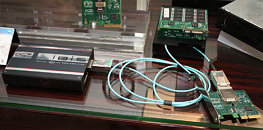Friday, January 7th 2011

OCZ Displays Optical HSDL Based IBIS XL Enterprise SSD
OCZ Technology also displayed its second generation Optical HSDL (high-speed data link) interface, and its first enterprise solid-state drive (SSD) that uses it. Last year, OCZ introduced HSDL as a replacement drive interface to SATA and SAS, to mainly serve the purpose of overcoming bandwidth bottlenecks. The first generation HSDL used an electronic link to the host card. The optical HSDL uses a fiber-optic cable to transfer data between the host and the drive.
The new interface is said to provide gains in access times, IOPS, and bandwidth in general. Fiber-optic cable also allows for better cable management (since it's thinner and round compared to serial cables (such as SATA, SAS), it probably also allows the cables to be longer, to help connecting a number of drives in a rack with the drive cage being at a distance from the host machine. Internally, the IBIS XL 3.5-inch form-factor SSD is a RAID 0 on a stick of two SSD sub-units. It can store up to 4 TB of data, and provide transfer speeds of 1800 MB/s (read) and 1700 MB/s (write), with 200,000 IOPS 4K write performance.
The new interface is said to provide gains in access times, IOPS, and bandwidth in general. Fiber-optic cable also allows for better cable management (since it's thinner and round compared to serial cables (such as SATA, SAS), it probably also allows the cables to be longer, to help connecting a number of drives in a rack with the drive cage being at a distance from the host machine. Internally, the IBIS XL 3.5-inch form-factor SSD is a RAID 0 on a stick of two SSD sub-units. It can store up to 4 TB of data, and provide transfer speeds of 1800 MB/s (read) and 1700 MB/s (write), with 200,000 IOPS 4K write performance.

3 Comments on OCZ Displays Optical HSDL Based IBIS XL Enterprise SSD
(of course, we'd need more than one for redundancy...)